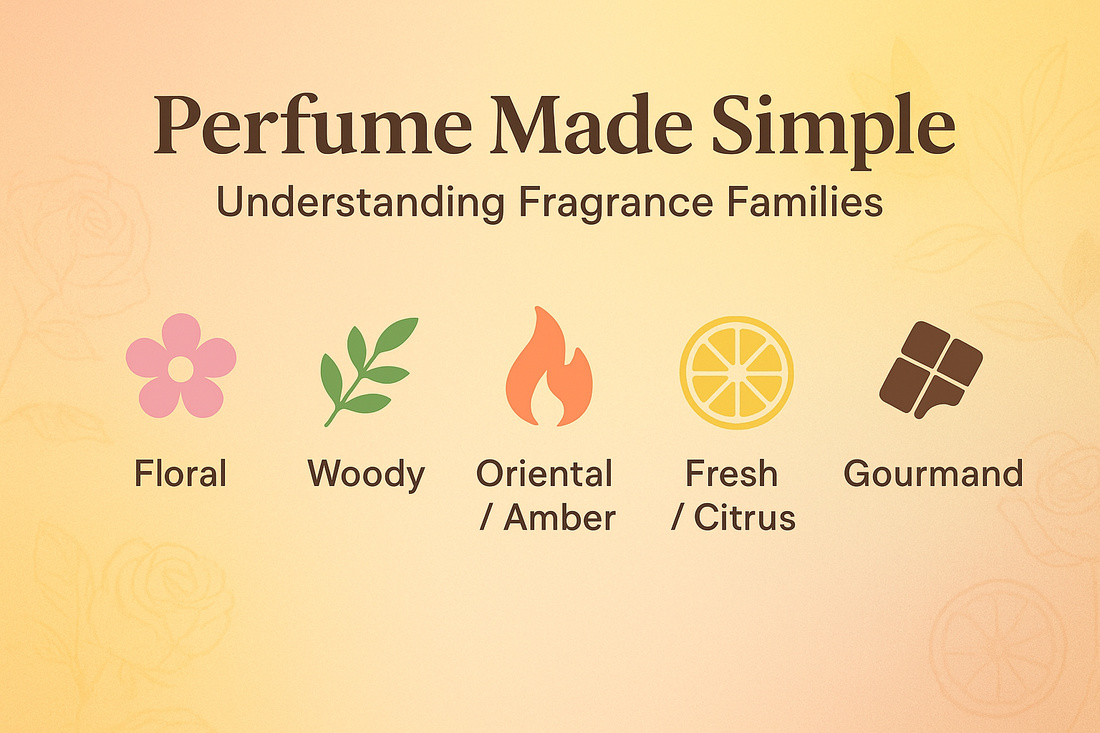
Perfume Made Simple: Understanding Fragrance Families
Share
Finding your signature scent can feel like a thrilling treasure hunt — but it can also get confusing fast. Walk into a perfume boutique and suddenly you’re surrounded by hundreds of bottles, all promising to be “the one.” The secret to navigating this world isn’t guesswork — it’s understanding fragrance families.
Fragrance families are the building blocks of perfumery. They group perfumes by their main scent character, making it easier to predict which ones you might love. Think of them like “genres” of music — some people love floral perfumes, others prefer woody or oriental scents, and some enjoy a mix. The more you understand the fragrance wheel and the main scent families, the more confident you’ll be when choosing your next perfume.
The Main Fragrance Families Explained
Floral – The Classics
Floral fragrances are the largest perfume family and celebrate the smell of flowers like rose, jasmine, tuberose, and peony.
Character: soft, romantic, sometimes powdery or dewy
Subfamilies: soliflores (single-flower perfumes), white florals (intense), fruity florals (playful and sweet)
Best for: everyday wear, weddings, spring and summer
Woody – Nature in a Bottle
Woody perfumes are warm, grounding, and timeless. They focus on earthy notes like sandalwood, cedarwood, patchouli, and vetiver.
Character: elegant, smooth, sometimes smoky
Subfamilies: dry woods (crisp, aromatic), creamy woods (soft and sweet), smoky woods (mysterious)
Best for: evening events, cooler months, anyone seeking a sophisticated fragrance
Oriental / Amber – Bold and Sensual
This perfume family is rich, spicy, and often sweet. They combine resins, spices, vanilla, and amber for a warm and lingering scent.
Character: exotic, sensual, often with strong projection
Subfamilies: floral amber (softened by flowers), spicy amber (clove and cinnamon), gourmand amber (sweet and edible)
Best for: nights out, special occasions, colder seasons
Fresh / Citrus – The Energizers
Fresh fragrances are uplifting and bright. Citrus perfumes feature notes like lemon, bergamot, grapefruit, and orange, often blended with green or marine notes for a crisp finish.
Character: clean, zesty, sparkling
Subfamilies: citrus aromatic (with herbs), aquatic perfumes (sea breeze), green perfumes (grassy and leafy)
Best for: hot weather, office wear, quick daytime refresh
Gourmand – The Delicious Ones
Gourmand perfumes smell almost edible. They feature notes like vanilla, caramel, chocolate, coffee, and honey for a cozy, indulgent effect.
Character: sweet, edible, warm, comforting
Subfamilies: dessert-like perfumes (rich and sweet), nutty scents (hazelnut, almond), fruity gourmands (berry desserts)
Best for: date nights, cozy evenings, cooler weather
Pro Tips for Finding Your Perfect Scent
> Start with your mood: Decide if you want something fresh and citrusy or warm and spicy before testing perfumes.
> Test on skin: Perfume develops differently on skin than on paper. Allow 10–20 minutes for the fragrance notes to evolve.
> Build a fragrance wardrobe: Having multiple perfumes lets you choose a scent that matches the season, occasion, or mood.
> Notice what gets compliments: Pay attention to which perfumes receive the most positive comments — they may belong to your ideal fragrance family.
Your Next Step
Now that you know the main perfume families, it’s time to explore them. Browse our shop by fragrance family online or visit us in-store to smell each type side by side. You may just find the signature scent that feels made for you.
